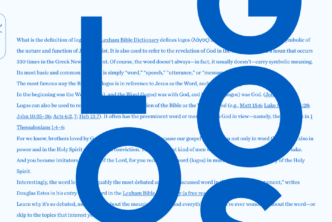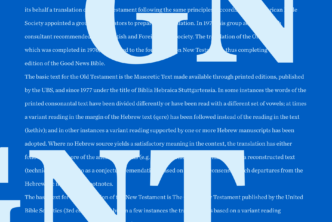Paul Overland (PhD, Brandeis University) is Professor of Old Testament and Semitic Languages at Ashland Theological Seminary.
There is a huge problem in the way that biblical Hebrew is currently taught: it doesn’t stick.
Polytetrafluoroethylene, or PTFE, is better known by its household name “Teflon.” It’s the coating on cookware that prevents food from sticking to the pan, and it’s the perfect term to describe the phenomenon that occurs in learning biblical Hebrew using traditional methods.
Here’s the question: Can biblical Hebrew ever recover its “stickiness”?
Recover stickiness? When was Hebrew ever sticky?
Listen to what the experts in modern language pedagogy say about language and original stickiness. They tell us that, when operating as intended, all language is hopelessly sticky.
Take an example from my childhood in Japan: “Egg” is tamago. Ahsobi-mahshoh means, “let’s play!” After decades of non-use, those entries still stick in my active memory. Without them I could neither grocery-shop for Mom nor summon buddies to play ball in our neighborhood, three hours outside Tokyo. Still today, those entries are “stuck.”
Experts account for such decades-old stickiness by pointing out that words such as “tamago” and “ahsobi-mahshoh” illustrate language operating as it was intended, foreign or otherwise. Language is exchanging messages. When courses introduce a language this way, we call it “Communicative Language Teaching.”
In the same way, by virtue of being a language, Hebrew has always been sticky, from the outset. Until we came along and cleverly coated it with Teflon, that is.
How did we deprive Hebrew of stickiness?
When we transferred language into the laboratory, when we immobilized idioms like insects pinned to a board, when we distilled pronominal suffixes to charts and left them there—that was when we stripped Hebrew of its stickiness.
Granted, there will always be a place for linguistic analysis and examination. But after analysis, experts tell us that we must unleash Hebrew to operate as originally intended—to facilitate meaningful communication. Teflon discourages communication.
Can Hebrew regain stickiness?
Yes, Hebrew can regain stickiness. Specialists in Second Language Acquisition have blazed the trail. I stumbled across it when foraging for a bit of Modern Hebrew (MH) in anticipation of an Israel trip.
On Tuesday afternoons, Mrs. Shtul (the energetic wife of a retired rabbi) would guide our discussions. By posing simple questions, she unleashed us to exchange with each other (in the target language) our eager insights surrounding the Shema and Ahavta (Deuteronomy 6:4–9).
For us, Hebrew had grown sticky because those insights would remain corralled within us until we swung open the communication gate. And the gate was made of Hebrew. We yearned to use Hebrew, not just to learn it.
During that course a realization dawned. Just as we were employing modern Hebrew to exchange ideas, so others could utilize biblical Hebrew to do the same. We lacked only two things. First, we needed a collection of communication-topics that learners would want to talk about. Second, we needed to supply learners with situation-sufficient language so they would be able to exchange those messages.
But random conversation topics and ad-hoc language components do not a comprehensive course make. A scheme, a syllabus must ensure that conversation topics coordinate with vital elements of grammar plus high-frequency vocabulary. This would ideally result in ever-increasing language competence.
Pioneering a new curriculum
Thanks to a substantial grant from the Wabash Center in 2005, several instructors began to develop a biblical Hebrew curriculum utilizing Second Language Acquisition resources. Watching over us throughout was Dr. Diana Pulido, a highly-regarded specialist in the art of training teachers of Spanish. ((For an account of that three-year journey, called the Cohelet Project, see “Can Communicative Principles Enhance Classical Language Acquisition?” in Foreign Languages Abstracts 44:3 (2011): 583–93 (written with the help of Lee Fields and Jennifer Noonan).))
While instructors test-piloted the Cohelet curriculum, two metrics dominated our attention. First, how were students responding to the new pedagogy? Second, could Hebrew instructors without training in either Modern Hebrew or SLA methodology conduct such a curriculum successfully?
As regards student response, learners found themselves pleasantly disarmed by the interactive approach fostered through sticky Hebrew. We heard of students who would keep on talking Hebrew out in the hallway after class was dismissed. Some asked that their Koine Greek please be taught like their Hebrew class. As Second Language Acquisition predicted, students preferred their language learning sticky.((See “Cognitive Style and Learning Strategies in Latin Instruction” by A. Deagon, pp. 27–49 in When Dead Tongues Speak: Teaching Beginning Greek and Latin, edited by J. Gruber-Miller (Oxford: Oxford University Press, 2006).))
As regards instructors, even without training in either Modern Hebrew or SLA methodology, teachers consistently returned highly positive reports. They admitted that their first-year learning curve reminded them of the investment required to teach any new course.
By the second year it typically leveled out. Most said that they certainly would not return to teaching “Teflon” Hebrew (via the Grammar-Translation method). It appears that the communicative pedagogy became as sticky for instructors as Hebrew became for students.
Several recent Hebrew textbooks offering insights into SLA are now available. Options include:
- Randall Buth, Living Biblical Hebrew
- John Cook and Robert Holmstedt, Beginning Biblical Hebrew (Baker Academic, 2013)
- Hélène Dallaire, Biblical Hebrew (Hélène Dallaire, 2016)
- Paul Overland, Learning Biblical Hebrew Interactively (Sheffield, 2014)
The crucial role of Logos Bible Software
Logos was instrumental in the Cohelet Project, and I surely recommend the Original Languages set of resources! Here’s an analogy to explain just how useful the program is. Boeing Aircraft Company is famous for extreme stress-testing of the metal (and now composition fiber) of its aircraft wings. Engineers deflect the customary curve of the airfoil up and down repeatedly, to the point that the wingtips threaten to touch. The process of developing the Cohelet Project textbook similarly tested the mettle of the Logos Bible Software.
If we could have broken Logos, it would have broken. After hundreds of morphological and syntactic searches, often with wildcard roots, the program held firm. Without the sophisticated search capabilities of Logos, the task of developing such a Hebrew textbook along communicative lines would have been as unthinkable as it would have been unbearable.
Logos also helps significantly beyond the curriculum development stage. From my experience in ministry, I’m persuaded that life is just too busy indulge playing Sherlock Holmes with a hardcopy of BDB, hunting down those elusive roots with weak radicals. Paper-and-ink sleuthing is enough to make my students abandon Hebrew altogether. So I require them to buy Logos, then strategically delaying its use until three months into the SLA language course.
See how to perform Hebrew clause searches in Logos Bible Software. Watch Video >>
What can we expect in the future?
Three opportunities in sticky Hebrew lie on the horizon: teacher training; new resources for advanced Hebrew courses and conversation; and digital enhancement of existing resources.
First, plans are under way for a two-week workshop for Hebrew instructors in the summer of 2017. It will enable Hebrew instructors to get comfortable using a communicative approach in their classrooms. (See the PDF flyer for the workshop at the bottom of this post.)
Second, materials are being developed that will enable instructors and advanced students to engage exegetical conversations concerning biblical passages they are exploring—all conducted in biblical Hebrew.
While the third opportunity (digital enhancements) may appear to orbit “in a galaxy far, far away,” that future is approaching at warp speed. It will be ushered in as enterprising virtual-world specialists venture to outfit existing graded-level stories in biblical Hebrew so they can blossom as interactive environments where learners will acquire language in the course of a role-playing game.
“Second Life” specialists will follow by creating a dedicated 3-D Hebrew island, complete with farmers and merchants, kings and clothiers, cooks and commoners, all beckoning the learner to carry on in biblical Hebrew.((Cf. “Language learning in virtual worlds: Research and Practice,” by Randall Sadler and Melinda Dooly, pp. 159–82 in Contemporary Computer-Assisted Language Learning, Michael Thomas, Hayo Reinders, and Mark Warschauer, eds. (London: Bloomsbury Academic, 2013).))
Circling in a nearer future orbit is another form of digital enhancement. Existing resources will be enhanced so that the reader can hear any Hebrew word, phrase, or sentence pronounced. Imagine opening the digital edition of a communicative Hebrew textbook, and with only a click, hearing the embedded conversations spoken aloud, not to mention all word lists and Bible readings.
Some are already approaching this standard by providing textbook story episodes with illustration, caption, and audiation available on the web.((http://www.learningbiblicalhebrewinteractively.com/Student, see Unit 2.1, Intro, Download Story Episode.)) Perhaps one day Logos will issue a digitized communicative textbook of this sort, in which all Hebrew is audio-clickable.
What’s the ultimate goal?
As fun as sticky Hebrew sounds (when was the last time “fun” and “Hebrew” appeared in the same sentence?), the end goal is not to inhabit some illusory island with a bunch of biblical Hebrew oral-revivalists. We don’t need conversational biblical Hebrew to order a kosher hamburger in Haifa.
The payoff, as Dr. Pulido enticed us at the start of the Cohelet Project, is of far greater worth. As learners acquire the language; as Hebrew achieves a level of automaticity within them; as they no longer must squander precious mental energies on lower-level decoding, they will release more of their native mental capacity for higher-level processing of what they are reading. In other words, students will read quicker with better comprehension.
Ideally, they will better be able to detect nuances latent in the text, i.e., those signals that so often unearth grand themes and delicate emphases. These are the very sorts of syntactic and lexical choices that so seldom clear the hurdle of translation; recall how artfully Isaiah and the psalmists craft their compositions.
Already instructors report that they themselves are reading Hebrew better since transitioning to communicative teaching. Learner-skill will commensurately climb as well. Ultimately, biblical Hebrew of a sticky sort will escort us into this new world of richer, more robust reading of the Hebrew Bible.
New to Hebrew, or need a brush-up? Get the Logos Mobile Ed bundle Introduction to Biblical Hebrew. For more information on learning biblical Hebrew interactively, visit Paul Overland’s website dedicated to the curriculum.





